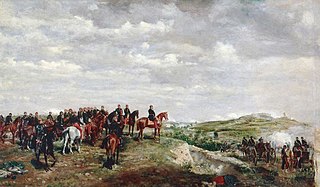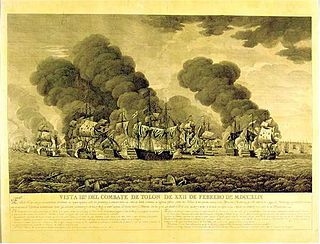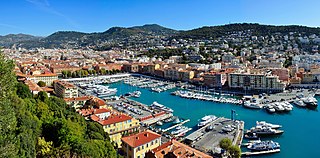
The Cottian Alps ; are a mountain range in the southwestern part of the Alps. They form the border between France and Italy (Piedmont). The Fréjus Road Tunnel and Fréjus Rail Tunnel between Modane and Susa are important transportation arteries between France and Italy (Turin).

Briançon is a commune in the Hautes-Alpes department in the Provence-Alpes-Côte d'Azur region in southeastern France. It is a sub-prefecture of the department.

Villefranche-sur-Mer is a commune in the Alpes-Maritimes department in the Provence-Alpes-Côte d'Azur region on the French Riviera and is located near the French~Italian border next to the Principality of Monaco.

The Second Italian War of Independence, also called the Franco-Austrian War, Austro-Sardinian War or Italian War of 1859, was fought by the French Empire and the Kingdom of Sardinia against the Austrian Empire in 1859 and played a crucial part in the process of Italian unification.

Mont Cenis is a massif and pass in Savoie (France), which forms the limit between the Cottian and Graian Alps.

Santorre Annibale De Rossi di Pomerolo, Count of Santa Rosa was an Italian insurgent and leader in the revival (Risorgimento) of Italy.
The Battle of Casteldelfino was a military engagement in July 1744 during the War of the Austrian Succession between France and the Kingdom of Sardinia.
The Battle of Madonna dell'Olmo or Battle of Cuneo was fought on the outskirts of Cuneo on 30 September 1744, in the War of the Austrian Succession. The battle ended in a victory for the armies of Spain and France over the Kingdom of Sardinia but it did not advance the victors' campaign.

The Battle of Mondovì was fought on 21 April 1796 between the French army of Napoleon Bonaparte and the army of the Kingdom of Sardinia-Piedmont led by Michelangelo Alessandro Colli-Marchi. The French victory meant that they had put the Ligurian Alps behind them, while the plains of Piedmont lay before them. A week later, King Victor Amadeus III sued for peace, taking his kingdom out of the First Coalition. The defeat of their Sardinian ally wrecked Austrian Habsburg strategy and led to the loss of northwest Italy to the First French Republic.

The Siege of Cuneo was fought on 28 June 1691 during Nine Years' War in Piedmont-Savoy, modern-day northern Italy. The siege was part of French King Louis XIV’s campaign against Victor Amadeus, the Duke of Savoy, who had sided with the Grand Alliance the previous year. The siege was an attempt to gain a foothold on the Piedmont Plain, thus ensuring Marshal Catinat's army could winter east of the Alps. Yet due to the incompetence of the two French commanders – and a timely arrival of Imperial reinforcements – the siege proved a disaster, resulting in the loss of between 700 and 800 men. Although French forces had taken Nice in the west, and Montmélian in the north, Catinat’s small, ill-equipped army was forced onto the defensive. Louis XIV subsequently offered Amadeus generous peace terms but the Duke, who had by now received substantial Imperial reinforcements from the Empire, considered himself strong enough to continue hostilities.

The Battle of Assietta was fought in the Italian campaign of the War of the Austrian Succession on 19 July 1747. It resulted in a defeat for France against the army of the Kingdom of Sardinia.
In the Battle of Ceva on 16 April 1796, troops of the First French Republic under Pierre Augereau fought against part of the army of the Kingdom of Sardinia-Piedmont led by General Giuseppe Felice, Count Vital. Augereau assaulted the strong defensive position without success. At the direction of the Sardinian army commander, Feldmarschal-Leutnant Michelangelo Colli, Vital withdrew on the 17th in order to avoid being trapped by a second French division.

The Battle of Loano occurred on 23–24 November 1795 during the War of the First Coalition. The French Army of Italy led by Barthélemy Schérer defeated the combined Austrian and Sardinian forces under Olivier, Count of Wallis.

The Montenotte Campaign began on 10 April 1796 with an action at Voltri and ended with the Armistice of Cherasco on 28 April. In his first army command, Napoleon Bonaparte's French army separated the army of the Kingdom of Sardinia-Piedmont under Michelangelo Alessandro Colli-Marchi from the allied Austrian army led by Johann Peter Beaulieu. The French defeated both Austrian and Sardinian armies and forced Sardinia to quit the First Coalition. The campaign formed part of the Wars of the French Revolution. Montenotte Superiore is located at the junction of Strada Provinciale 12 and 41 in the Liguria region of northwest Italy, 15 kilometres (9 mi) northeast of Carcare municipality. However, the fighting occurred in an area from Genoa on the east to Cuneo on the west.
The Segusini were a Gaulish tribe whose territory largely corresponded with the ancient Roman province of Alpes Cottiae, in the Cottian Alps.

The Battle of the Baztan Valley was fought between 23 July and 1 August 1794 during the French Revolutionary War, between a French force from the Army of the Western Pyrenees commanded by Bon-Adrien Jeannot de Moncey and the Spanish forces led by Don Ventura Caro. The French army drove the Spanish from their defenses, then followed the valley northward to the Atlantic coast. The Spanish forces holding the coastal defenses were compelled to surrender or flee.

The Battle of Saorgio was fought from 24 to 28 April 1794 between a French First Republic army commanded by Pierre Jadart Dumerbion and the armies of the Kingdom of Sardinia-Piedmont and the Habsburg Monarchy led by Joseph Nikolaus De Vins. It was part of a successful French offensive designed to capture strategic positions in the Maritime Alps and Ligurian Alps, and on the Mediterranean coast. Tactical control of the battle was exercised by André Masséna for the French and Michelangelo Alessandro Colli-Marchi for the Coalition. Saorge is located in France, about 70 kilometres (43 mi) northeast of Nice. At the time of the battle, the town was named Saorgio and belonged to Piedmont.

The First Battle of Saorgio saw a Republican French army commanded by Gaspard Jean-Baptiste Brunet attack the armies of the Kingdom of Sardinia-Piedmont and Habsburg Austria led by Joseph Nikolaus De Vins. The local Sardinian commander in the Maritime Alps was Charles-François Thaon, Count of Saint-André. Though the French were initially successful in this War of the First Coalition action, their main assaults against the strong defensive positions on the Massif de l'Authion and the Col de Raus failed with serious losses. Saorge is now located in France about 70 kilometres (43 mi) northeast of Nice, but in 1793 Saorgio belonged to Piedmont. In April 1794 the French seized the positions from the Austro-Sardinians in the Second Battle of Saorgio.

The Second Battle of the Alps was a military campaign fought between combined German and Italian Social Republic forces, and the re-established French Republic led by Charles de Gaulle.

























